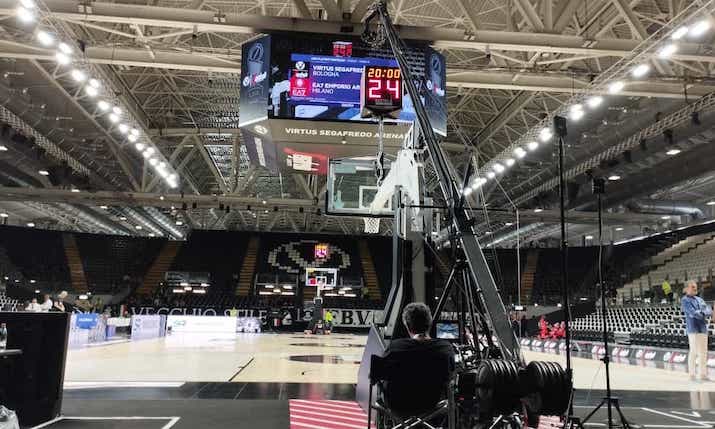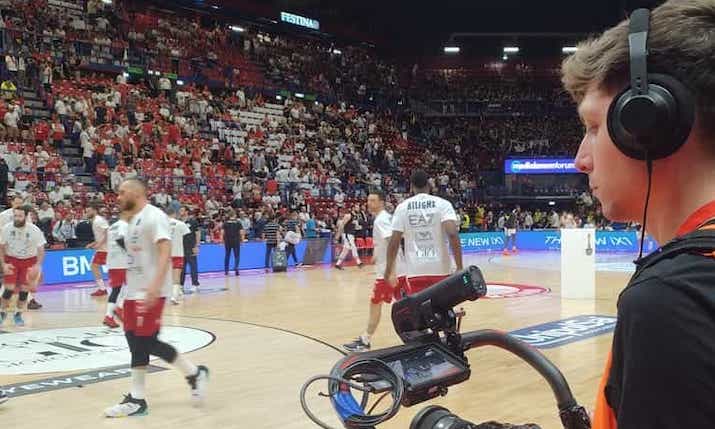Power up: EMG Italy introduces innovations aplenty as Lega Basket Serie A season reaches dramatic conclusion

A 13-metre jimmy-jib positioned behind the basket created new and dynamic shots
The 2022-23 season of Italy’s Lega Basket Serie A (LBA) basketball league reached its conclusion on 23 June with a best-of-seven play-off final featuring Olimpia Milano and Virtus Bologna. With the teams tied after winning three games apiece, it all came down to the final match, held at the Mediolanum Forum in Assago, where EMG Italy was on hand to capture the drama.
EMG Italy has been collaborating with the LBA for broadcast services for around six years. This year it handled TV production for the championship, including filming the playoff matches, which were broadcast free to air on Nove, as well as via paid services on Eurosport, Eleven Sports and DAZN.
Production methods
Paolo Sassano, sports production coordinator of EMG Italy, says: “The whole LBA basketball championship this year was exciting and the final was very tight because it went all the way to the last match.”
For the first time, the season was managed in hybrid mode, with mobile vehicles on site in some of the arenas and other matches produced remotely.
Sassano adds: “For this season we redesigned the basketball production set-up, with the aim of standardising the final product as much as possible for the user and, in agreement with the LBA, we chose to produce two or three games remotely out of the eight played every weekend.”
Anna Pasculli, sales manager of EMG Italy, says: “It was certainly a year of great success and great changes for basketball TV production, where we introduced several important variations.
“For the first time in Italy, on a sport other than football, we launched a centralised and remote service via the Instant Replay Center in Cologno Monzese. It is extraordinary because from a centralised location it is possible to supervise everything that is managed by the on-site referees. Just as the main international broadcasters around the world are exploiting cloud-based remote production every day for high-value content – centralised and in real time – so EMG Italy, thanks to our remote production hub in Cologno, is today a consolidated reality.”
An Instant Replay Center dedicated to the LBA has been created at EMG Italy’s broadcast centre in Cologno Monzese, with eight stations connected to the pitches, which allows the instant replay service to be centralised: upon request, the referees can review dubious game action from different angles, at reduced speed, frame by frame or zoom.
Regular season and finals
EMG Italy created the host feed of all matches throughout the season. This involved eight matches for 30 rounds in the regular season, meaning a total of 240 matches, along with another 30 for the play-offs.
For the finals, which were all produced on site, some innovations were introduced to make the coverage even more spectacular. The most important change was the ability to broadcast the audio of the referees during their instant replay analysis for the first time.
The audio of these moments was recorded by a dedicated sound engineer, equipped with a microphone boom who accompanied the operator with a shoulder camera during the game. In the event of an instant replay call, the sound engineer was therefore able to hear the audio of the two referees on the pitch, their arguments and their requests to the instant replay operator.
The same sound engineer-operator pair also captured the images and audio of the coaches during the time out.
Camera plan
More cameras were also used during the finals, with EMG director Max Ceriani supervising their positioning.
The layout consisted of 10 cameras: the main one followed the game and was flanked by camera 2, which covered the details and narrow pitches of the game. The setup also included three shoulder cameras, one central and two positioned under the basket, as well as two remote micro-cameras high up on the backboards.
A 13-metre jimmy-jib positioned behind one of the baskets (based on the available space and escape routes) created new and dynamic shots, following the entire match and creating horizontal and vertical movements.
A reverse camera filmed the benches, close-ups of the referees and close-ups of the VIPs in the opposite grandstand. Finally, a further handheld camera with cinematic optics, mounted on a gimbal support with an RF system, was free to move around the court and in the stands to capture filler shots and as many details as possible.

A handheld camera captured filler shots around the court
The TV compound
All television production was entrusted to EMG Italy, while Infront, a partner of Lega Basket Serie A, was responsible for distributing the signals abroad by adding commentary in English created in the production centre in via Deruta in Milan.
The main direction of EMG Italy equipped with 4K HDR cameras created an HD feed. In addition to the host signal, an integration was also produced for Warner Bros. Discovery group channels Eurosport and Nove.
The TV compound also included a support truck, a generator set and the integration mobile van for Warner Bros. Discovery.
Graphics were created by EMG’s Boost Graphics, which developed a new presentation of the starting quintet of the players with the line-up displayed on the field.
“The personnel of these productions,” continues Sassano, “are usually engaged in the setup from the day before the match. However, we often find ourselves creating a setup that would require eight hours of work, because the arenas are always busy. On average, we usually need at least six hours of setup with a 25-person crew.”
On the move to remote production, Pasculli added: “We started with REMI for the lower tier sports, but then extended it to basketball in standard A and we are confident that we will continue to carry out this project which will allow us to control and manage all the productions from the courts.
“The idea of ‘remote’ for EMG Italy is precisely this, to have centralised control and a much greater fluidity of the processes. This brings tangible advantages that translate into greater uniformity of productions, greater standardisation and therefore a less artisanal and more complete product for the passionate television audience.”

